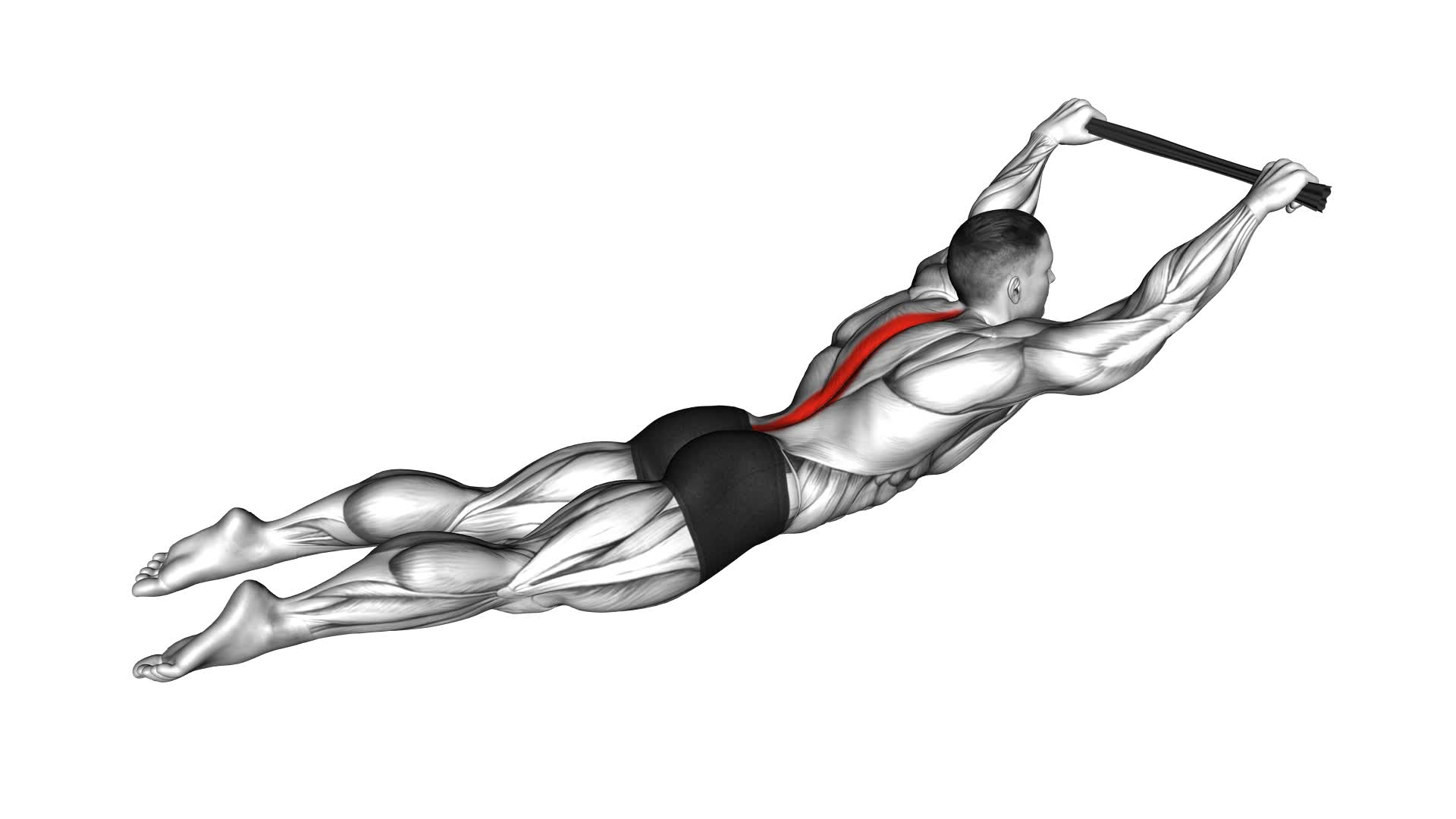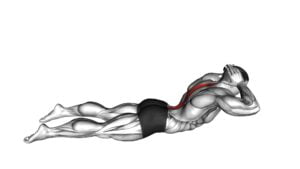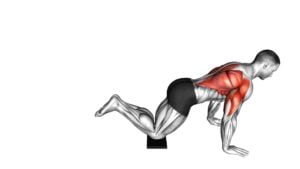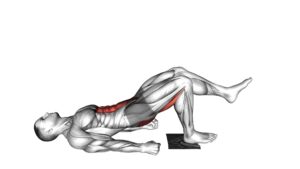Lying Floor Hyperextension With Towel – Video Exercise Guide & Tips

Are you looking for an effective exercise to strengthen your lower back and core muscles? Look no further than the lying floor hyperextension with towel.
Watch This Exercise Video
This exercise, demonstrated in a helpful video guide, targets your posterior chain and can be done at home with minimal equipment.
Avoid common mistakes and maximize effectiveness with expert tips.
Whether you're a beginner or advanced, this exercise has variations and progressions to suit your fitness level.
Get ready to feel the burn!
Key Takeaways
- Lying floor hyperextension strengthens lower back muscles and targets erector spinae muscles responsible for spinal extension and stability.
- It improves posture and increases lower back muscle strength and endurance, reducing the risk of lower back pain and injuries.
- Variations and modifications of the exercise can target different muscle groups, add variety to workouts, and challenge abdominal muscles.
- Proper form and positioning, along with listening to your body and prioritizing safety, are important for maximizing effectiveness and preventing strain or injury.
Benefits of Lying Floor Hyperextension
To understand the benefits of lying floor hyperextension, you should know that it can effectively strengthen your lower back muscles. The lying floor hyperextension technique involves lying face down on the floor with your legs extended and your hands placed behind your head or crossed on your chest. From this position, you lift your upper body off the floor while keeping your lower body grounded, engaging your lower back muscles.
This exercise primarily targets the erector spinae muscles, which run along your spine and are responsible for spinal extension and stability. By regularly incorporating lying floor hyperextensions into your workout routine, you can improve your posture, increase the strength and endurance of your lower back muscles, and reduce the risk of lower back pain and injuries.
There are various variations and modifications of the lying floor hyperextension technique that you can try to add variety to your workouts and target different muscle groups. For example, you can perform the exercise with your arms extended overhead or with weights held against your chest to increase the intensity. Additionally, you can try performing the exercise on an inclined bench or stability ball to challenge your core stability and engage your abdominal muscles.
As with any exercise, it's important to start with proper form and gradually increase the difficulty level as your strength and endurance improve.
Proper Equipment and Setup
To properly set up for the lying floor hyperextension exercise, you'll need essential equipment such as a towel or mat for comfort and support. It's important to ensure that your form and positioning are correct to maximize the effectiveness of the exercise.
Maintaining a straight body alignment and positioning the towel or mat under your hips will help you maintain stability and prevent strain or injuries.
Essential Equipment for Setup
To properly set up and perform the lying floor hyperextension with towel exercise, you'll need essential equipment.
There are a few equipment options you can choose from to ensure a proper setup.
Firstly, you'll need a flat and comfortable surface to lie on, such as a yoga mat or exercise mat. This will provide support and cushioning for your body.
Additionally, you'll need a towel that's long enough to reach from your hips to your ankles. This towel will be folded and placed under your hips to provide stability during the exercise.
Correct Form and Positioning
How should you position yourself and utilize the proper equipment for the lying floor hyperextension with towel exercise?
The key to performing this exercise correctly is to ensure proper form and positioning.
First, lie face down on the floor with your legs extended and your upper body supported by your forearms.
Place a towel under your hips to provide support and cushioning.
Make sure your feet are secured under a stable object or have someone hold them down to prevent them from lifting off the ground.
Maintain a neutral spine throughout the exercise, avoiding excessive arching or rounding of the back.
Common mistakes to avoid include using momentum to lift your upper body and allowing your hips to lift off the towel.
By following the proper technique and positioning, you can maximize the benefits of the exercise and reduce the risk of injury.
Now, let's move on to the step-by-step guide to performing the exercise.
Step-by-Step Guide to Performing the Exercise
Now, let's dive into the step-by-step guide for performing the lying floor hyperextension with a towel exercise.
This exercise is all about maintaining proper form, so make sure to follow these tips closely.
We'll also discuss common mistakes to avoid and highlight the benefits of incorporating this exercise into your routine.
Proper Form Tips
When performing the lying floor hyperextension with towel exercise, it's important that you engage your core and maintain proper form throughout the movement. Here are some proper form cues to keep in mind:
- Start by lying face down on the floor with your legs extended and a towel placed under your hips.
- Place your hands behind your head, keeping your elbows wide.
- Engage your core muscles and lift your chest off the floor, using your lower back muscles.
- Slowly lower your chest back down to the starting position, maintaining control throughout the movement.
Common errors to avoid include:
- Arching your back excessively, which can strain your lower back.
- Using momentum to lift your chest, instead of relying on your back muscles.
- Letting your head drop forward or tucking your chin, which can strain your neck.
Common Mistakes to Avoid
To ensure proper execution of the lying floor hyperextension with towel exercise, it's crucial to be aware of common mistakes that should be avoided.
One common mistake is using too much momentum to lift your upper body off the ground. This can diminish the effectiveness of the exercise and put unnecessary strain on your lower back.
Another mistake to avoid is rounding your back during the movement. To maintain proper technique, keep your spine in a neutral position throughout the exercise.
Additionally, it's important to avoid pulling on the towel excessively or using it to swing your body. Instead, focus on engaging your core and using your back muscles to perform the movement.
Benefits of Exercise
You can experience several benefits by performing the lying floor hyperextension with towel exercise.
- It helps strengthen your lower back muscles, improving your posture and reducing the risk of lower back pain.
- This exercise also targets your glutes, hamstrings, and core muscles, contributing to a stronger, more stable core.
- By engaging multiple muscle groups, it enhances overall muscular strength and endurance.
- Incorporating the lying floor hyperextension with towel exercise into your workout routine can also improve your flexibility and range of motion.
Before starting this exercise, it's important to warm up properly to prepare your body for the movements. Additionally, including this exercise in different types of exercise programs, such as strength training or core workouts, can help you achieve a well-rounded fitness regimen.
Now let's move on to the next section and learn about common mistakes to avoid.
Common Mistakes to Avoid
To ensure proper form and maximize the effectiveness of the lying floor hyperextension with towel exercise, it's crucial to avoid these common mistakes.
- One of the most common mistakes isn't using the towel correctly. Make sure to place the towel under your hips, just above the glutes, to provide support and stability during the exercise.
- Another common mistake is using too much momentum. Remember, this exercise is meant to target the lower back and glutes, so it's important to perform the movement slowly and controlled. Using momentum can take away from the effectiveness of the exercise and increase the risk of injury.
- Additionally, it's important to avoid arching the back excessively. While some arch is natural, excessive arching can put unnecessary strain on the lower back and lead to discomfort or injury. Focus on maintaining a neutral spine throughout the exercise.
- Lastly, avoid lifting the legs too high. The goal of this exercise is to engage the lower back and glutes, not to lift the legs as high as possible. Lifting the legs too high can strain the lower back and decrease the effectiveness of the exercise.
Tips for Maximizing the Effectiveness
Maximize the effectiveness of the lying floor hyperextension with towel exercise by focusing on proper form and incorporating progressive resistance. To ensure that you're getting the most out of this exercise and maximizing your results, consider the following tips:
- Engage your core: Throughout the exercise, make sure to keep your core muscles activated. This will help stabilize your body and prevent any unnecessary strain on your lower back.
- Maintain a neutral spine: Keep your spine in a neutral position throughout the movement. Avoid arching your back excessively or rounding your shoulders.
- Gradually increase resistance: As you become more comfortable with the exercise, gradually increase the resistance by using a thicker towel or adding weights. This will challenge your muscles and stimulate further strength gains.
- Control the movement: Focus on the controlled and deliberate movement of your body. Avoid using momentum or swinging your legs to complete the exercise. This will ensure that you're targeting the correct muscles and maximizing the effectiveness of the exercise.
Variations and Progressions for Advanced Users
To take your lying floor hyperextension with towel exercise to the next level, incorporate advanced variations and progressions.
These modifications will challenge your muscles even more and help you continue to make progress in your fitness journey.
One advanced variation is the weighted lying floor hyperextension with towel. Instead of just using your body weight, you can hold a weight plate or a dumbbell against your chest while performing the exercise. This added resistance will increase the intensity and target your lower back and glutes even more.
Another advanced progression is the single-leg lying floor hyperextension with towel. This exercise requires you to perform the movement with one leg lifted off the ground. By doing so, you engage your core muscles to stabilize your body and increase the workload on your lower back and glutes.
To further challenge yourself, you can also try performing the lying floor hyperextension with towel on an unstable surface, such as a stability ball or a Bosu ball. This will require more stability and coordination, engaging additional muscles to maintain balance throughout the exercise.
Incorporating these advanced variations and progressions into your lying floor hyperextension with towel routine will help you continue to build strength and improve your overall fitness level.
Remember to always listen to your body and progress at a pace that feels comfortable for you.
Frequently Asked Questions
Can Lying Floor Hyperextensions Help Improve Posture?
Lying floor hyperextensions can indeed help improve your posture. Compared to other back exercises, this exercise specifically targets the muscles in your lower back and glutes, which play a crucial role in maintaining good posture. By strengthening these muscles, you can alleviate lower back pain and support proper spinal alignment.
Additionally, lying floor hyperextensions promote core stability and increase overall back strength, making it an effective exercise for improving posture.
Are Lying Floor Hyperextensions Safe for Individuals With Lower Back Pain?
Lying floor hyperextensions can be safe for individuals with lower back pain, but it's important to consult with a healthcare professional first. Compared to other lower back exercises, lying floor hyperextensions can provide unique benefits for overall fitness.
They help strengthen the muscles in your lower back, improving posture and reducing the risk of injury. However, it's crucial to start with proper form and gradually increase intensity to avoid exacerbating any existing pain or discomfort.
Always listen to your body and modify the exercise as needed.
How Often Should Lying Floor Hyperextensions Be Performed for Optimal Results?
To improve flexibility and prevent injury, it's important to perform lying floor hyperextensions regularly. These exercises target the lower back muscles, helping to strengthen and stabilize the area.
While the optimal frequency may vary depending on your individual goals and fitness level, a good starting point is to aim for 2-3 sessions per week. Consistency is key, so make sure to give your body enough time to recover between workouts.
Consulting with a fitness professional can also help tailor a specific routine for you.
Can Lying Floor Hyperextensions Help Strengthen the Core Muscles?
Lying floor hyperextensions can be beneficial for strengthening your core muscles. By performing this exercise with proper form, you can target your lower back, glutes, and hamstrings, while also engaging your core.
The movement involves extending your body backwards, using a towel for support. This exercise can help improve your overall core stability and strength.
Make sure to follow the proper technique and consult with a fitness professional if needed.
Are There Any Modifications or Alternatives to Lying Floor Hyperextensions for Those With Limited Mobility?
If you have limited mobility and are unable to perform lying floor hyperextensions, don't worry! There are seated modifications and resistance band alternatives that can still help strengthen your core muscles.
By modifying the exercise to a seated position, you can focus on engaging your core while sitting upright.
Another alternative is using a resistance band to mimic the movement of the lying floor hyperextension.
Both options provide a great way to work your core muscles without putting strain on your mobility limitations.
Conclusion
In conclusion, the lying floor hyperextension with a towel is a beneficial exercise for strengthening the lower back muscles. By following the proper equipment setup and step-by-step guide, you can perform this exercise effectively and avoid common mistakes.
To maximize its effectiveness, remember to engage your core and maintain proper form throughout. Advanced users can also explore variations and progressions to challenge themselves further.
Incorporate this exercise into your fitness routine for a stronger and healthier back.

Author
Years ago, the spark of my life’s passion ignited in my mind the moment I stepped into the local gym for the first time. The inaugural bead of perspiration, the initial endeavor, the very first surge of endorphins, and a sense of pride that washed over me post-workout marked the beginning of my deep-seated interest in strength sports, fitness, and sports nutrition. This very curiosity blossomed rapidly into a profound fascination, propelling me to earn a Master’s degree in Physical Education from the Academy of Physical Education in Krakow, followed by a Sports Manager diploma from the Jagiellonian University. My journey of growth led me to gain more specialized qualifications, such as being a certified personal trainer with a focus on sports dietetics, a lifeguard, and an instructor for wellness and corrective gymnastics. Theoretical knowledge paired seamlessly with practical experience, reinforcing my belief that the transformation of individuals under my guidance was also a reflection of my personal growth. This belief holds true even today. Each day, I strive to push the boundaries and explore new realms. These realms gently elevate me to greater heights. The unique combination of passion for my field and the continuous quest for growth fuels my drive to break new ground.







